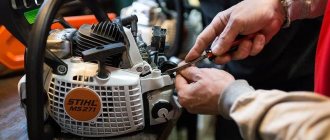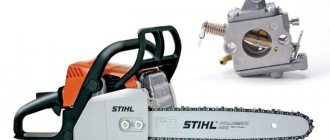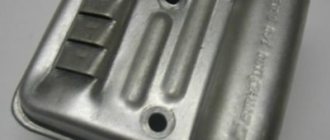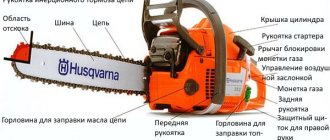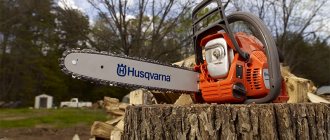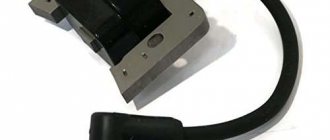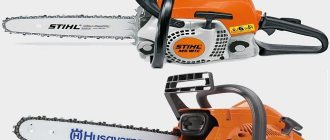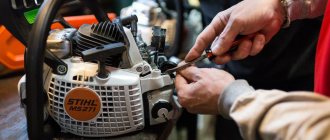Problems with the fuel supply system
If the tool does not work, this may be due to the fact that fuel is not entering the cylinder. First of all, you need to check the fuel filter for contamination levels.
To check this, you need to remove the fuel hose and check how fast the fuel flows. If it is supplied under low pressure, then the problem lies in the filter.
In this case, you need to clean the filter. It is taken directly through the tank. The filter is cleaned and installed back. It is washed under running clean water.
After this, the filter is dried and carefully installed back. To prevent this problem from occurring in the future, it is necessary to periodically clean the filter.
If cleaning the filter does not give a positive result, then you should pay attention to the breather. A clogged hole in this hole causes insufficient air to enter the carburetor.
Expert advice: when troubleshooting such faults, you must use the instructions, this will prevent more serious breakdowns from occurring.
Why does a chainsaw stall when you press the gas?
Let's say the chainsaw operates normally at idle, but when you press the gas sharply it stalls. What could be the reason? It is immediately clear that the issue is not the ignition (lack of spark), because if the ignition was faulty and there was no spark, the tool simply would not start. This means the fuel system remains.
There are a lot of malfunctions in the fuel system, and to determine the exact reason why the Stihl 180 chainsaw stalls when you press the gas, it is necessary to carry out a complete diagnosis of it. We recommend reading about common malfunctions of the Shtil 180 chainsaw and their elimination.
Filter check
The first thing you need to check is the fuel filter.
In some cases, a filter clogged with dirt is unable to pass through the fuel mixture in sufficient quantities. Accordingly, there is a shortage of fuel in the system, which leads to the fact that when you press the gas of the chainsaw, the fuel burns out, and new fuel does not yet have time to arrive, as a result of which the Shtil chainsaw stalls.
Also, if the fuel filter is clogged, there may be a noticeable drop in the power of the chainsaw at maximum speed, but this is with minor contamination.
Air filter
On the pages of the World Wide Web, you can find information that the Shtil 180 chainsaw may stall due to severe contamination of the air filter.
I would like to refute this not entirely correct information and report that the Shtil MC 180 carburetor is equipped with a compensator, which is designed and installed in order to take in the air necessary for the normal operation of the Shtil 180 chainsaw, bypassing the dirty air filter.
Of course, the power with a clogged air filter will drop slightly, but it definitely won’t stall. The power may also drop due to piston wear, which will require repair of the Stihl MS 180 piston chainsaw.
Carburetor
One of the reasons why a chainsaw does not develop speed when you press the gas, but rather stalls, is a malfunction of the carburetor.
Let’s say the Shtil 180 saw worked properly, and then it was installed for a long time and was not used.
Afterwards it was started, and at idle it works well, but when you press the gas it can stall.
Why does it stall? The reason is a stuck carburetor valve nozzle. Of course, this is not 100%, but the probability of such a malfunction is high. We recommend reading the article about the design and repair of the Shtil 180 carburetor.
In order to check the nozzle, you need to remove the carburetor and disassemble it. To remove, you need to unscrew the two nuts securing the air filter and the carburetor, then remove the air filter and the engine control lever, while disconnecting the air damper control rod from the carburetor. Next, you need to slightly pull the carburetor towards you and disconnect the fuel supply hose.
After removing the carburetor, you need to blow it out and clean it of dirt, only after that the carburetor can be untwisted.
It is necessary to unscrew the cover of the main chamber of the carburetor; this is the one on which the compensator is installed on top. Next, use an 8 mm bolt and a length of at least 50 mm. We knock out the valve.
After the nozzle is removed, you can blow it out using a compressor. The valve should only allow air to flow in one direction; if the valve can be freely blown in both directions, it means it is faulty and needs to be replaced with a new one. Reassembling the chainsaw after the valve has been repaired must be carried out in the reverse order of disassembly.
You can see clearly how a carburetor is repaired, or rather, how to correctly knock out the injector valve from the carburetor body by watching the video.
Another common reason why a saw may stall when the speed increases is air leaking into the carburetor. This can only be checked with a special tool, but it is worth noting that if preventive work has not been carried out on the carburetor for a long time, then you can install a new set of gaskets in the carburetor. In some cases, this helps solve the problem of its depressurization.
When disassembling the carburetor to replace the gaskets, you need to carefully inspect its needle valve, press the rocker arm and check its lifting.
Sometimes, especially after the Stihl chainsaw has stood for a long time with fuel in the carburetor, the needle may burn to the carburetor body and not perform its functions. Simply put, the needle valve will not allow the fuel mixture to pass through. In this case, the saw will not work.
Why it won’t start and what to do
Among the malfunctions of the Husqvarna chainsaw are poor engine starting. The engine either cannot be started at all, or it starts poorly.
There is no clear answer to the question why the chainsaw won’t start. The main assembly unit of the tool is the engine. The following conditions affect the stability of operation:
- fuel mixing;
- air;
- presence of a spark;
- lubricant
Each factor is responsible for its own working unit:
- for the fuel mixture - carburetor;
- for air - a cleaning system, in particular an air filter;
- for the spark - the ignition mechanism and spark plug;
- lubrication - lubrication system and gasoline.
A common reason why chainsaws do not start is failure to follow the starting algorithm. The engine unit should only be started after all parts have been completely assembled:
- tires;
- saw chain;
- caps
The chain brake is always on. To avoid losing control of the instrument, you must not start in the air.
Starting the engine in a cold state is done as follows:
- Place the tool on the ground, step on the back handle with your right foot, and place your left hand on the front handle.
- The saw is in a stable state, the chain does not touch the ground.
- With your right hand, take the starter handle and pull the cord, but do not twist it around your hand.
- As soon as the first flash occurs, return the choke lever to its initial position, opening it, and repeat the start.
- They gas it and let it go. The blocking is disabled.
- The engine is switched to idle speed by quickly turning off the gas limiter.
Starting a warm engine is carried out in the same sequence, but without opening the damper.
If the start is made correctly, but the engine does not work, a possible reason is the lack of fuel in the tank, or the carburetor fuel chamber is not filled. Check the tank and chamber, fill them with the mixture.
If the ignition system malfunctions, inspect the spark plug and check for the presence of a spark at the electrodes. If it is wet (gasoline floods the spark plug) and a spark is not detected, the part is turned out, dried or replaced. If it is dry and there is a spark, then there is a problem in the fuel equipment - clogging, depressurization of the gas intake.
Magneto malfunctions are also confirmed by a weak spark. Despite the ignition operation, there may be no flash in the cylinder, while the spark plug removed from the cylinder is wet. The solution is to purge the cylinder with the carburetor flaps open.
The electrodes of the system are covered with soot or oily. This can be removed with a wire brush. The spark plug is washed and cleaned by allowing the gasoline to evaporate.
Violation of the gap between the side and central electrodes leads to a poor start. The normal interval is 0.6-0.7 mm. It is adjusted by hemming.
If the ceramic insulator surrounding the central spark plug or the current-carrying core of the wire is damaged, replace it.
If it starts and stalls
The Husqvarna chainsaw starts and stalls when you press the gas. This is caused by a clogged carburetor jet and a dirty fuel tank filter. The defect is eliminated as follows:
- disconnect the fuel hose from the carburetor;
- inspect the fluid leakage - the breather is clean if a full stream comes out.
The next reason why a chainsaw stalls is contamination of the muffler with exhaust resins. The issue can be resolved by cleaning.
Wear of piston rings affects the operation of the cylinder-piston group. If there is play during inspection, parts are replaced.
When starting the engine, the unit may also stall:
- as a result of water entering the mixture;
- due to poor chain lubrication;
- oil wire leakage;
- clogged channels.
Pay attention to the chain:
- if dryness increases, clean the oil supply channels, inspect the elements connecting the fittings to the tubes;
- If there is an oil leak at the connecting points or there are cracks in the tubes, they are sealed with sealant.
The engine does not develop speed:
- if the piston rings burn in the grooves;
- when the crankcase rubber seals wear out and lose elasticity;
- leaks in the connection between the cylinder and the crankcase;
- due to incorrect setting of the ignition timing;
- as a result of contamination of the cylinder fins and fan grille;
- under heavy load immediately after purchasing a new engine.
Why does the Shtil chainsaw not start when it's hot? Why does a chainsaw have trouble starting?
Main reasons:
- fuel and air filters;
- reduced compression;
- carburetor adjustment;
- spark plug;
- ignition coil;
- gap between the ignition coil and the flywheel;
Let's look at each reason in more detail.
Fuel and air filter
Contamination of the main filter elements of a chainsaw negatively affects its operation.
For example, a dirty air filter will not provide enough air to the carburetor, which will affect the quality of the air-fuel mixture and normal engine starting. A dirty fuel filter will make it difficult or even cut off the flow of gasoline to the carburetor and make it impossible for the engine to operate.
Reduced compression
One of the common cases of difficult starting of a chainsaw is wear of the CPG (cylinder-piston group).
As you know, for a chainsaw to start normally, compression must be present in its engine. It is necessary for normal compression of the fuel mixture in the engine cylinder, and it also affects the operation of the fuel pump.
During the operation of the tool, the compression value drops and the chainsaw begins to have difficulty starting.
The reasons for the lack of compression or its decrease may be natural, because The engine wears out during operation. Problems can also be caused by a serious breakdown, for example, a scuffed CPG, or a broken piston ring.
A sign of low compression is weak starter resistance when starting. With reduced compression, a decrease in the power of the chainsaw is observed, which negatively affects its performance. The problem is eliminated by replacing the piston rings, or the entire CPG.
Carburetor adjustment
Incorrect carburetor adjustment will cause the chainsaw to not develop full power. It will be difficult to start, or not start at all. Carburetor settings directly affect the quality of the air-fuel mixture, which is necessary for normal starting and further operation of the engine.
If the carburetor is incorrectly adjusted, there will be more or less gasoline in the fuel-air mixture than required, and the mixture will not ignite even with normal sparking.
Excess gasoline in the mixture is usually called overflow. A characteristic sign of overflow is a wet spark plug, after several unsuccessful attempts to start the chainsaw.
Spark plug
The spark plug is one of the main elements of the ignition system. A spark is formed at its electrodes, and if this element fails, starting will be difficult or not possible at all.
The spark plug may fail completely, or work intermittently or produce a weak spark. Checking the spark plug is quite simple; to do this, you need to unscrew it from the engine, attach it to the cap of the high-voltage wire and, placing it on the cylinder, pull the starter. If the spark plug is in order, the spark will be powerful with a bluish tint. A weak spark with a reddish tint is a sign of a problem. A defective spark plug needs to be replaced.
Ignition coil
The reason that a new chainsaw does not start, or starts poorly, may be the ignition coil. Modern chainsaws are equipped with electronic ignition coils. This part cannot be repaired, and, as a rule, if there is a defect, it is completely replaced.
Husqvarna 240 chainsaw device
The main difference between the Husqvarna 240 chainsaw and most market analogues is the excellent quality of its factory assembly. The garden tool is equipped with a durable 2-stroke gasoline engine with a cylinder volume of 38.2 cm3. The engine is equipped with a reliable manual starter, a proprietary Japanese Walbro carburetor, a hand pump for pre-priming fuel, and a fuel tank.
For more convenient operation, the Husqvarna 240 chainsaw is equipped with a modified vibration suppression system. The system includes 6 metal springs, which, when the internal combustion engine is operating at maximum speed, absorb the vibrations of the crankshaft. Thus, vibration on the handles of garden tools is practically not felt.
For continuous connection of the engine with the sawing bodies, the model is equipped with a durable clutch, all spare parts of which are made of metal that is highly resistant to wear and corrosion. A high-quality ignition system consisting of a coil, spark plug and electrical wiring is responsible for igniting the fuel in the internal combustion engine cylinder.
The garden tool saw set includes a steel bar and a chain, which is lubricated by an automatic oil pump. The chain for the Husqvarna 240 chainsaw is tensioned using a side sprocket. To ensure an emergency stop of the headset if it hits a nail or metal wire, the model’s device is equipped with a long-lasting inertial brake, which can be turned on and off using a separate lever.
The Husqvarna chainsaw in the 240th modification is equipped with a reliable body made of impact-resistant plastic. It has separate plates that can be removed if necessary. This simplifies carburetor repair and replacement of chainsaw consumable parts.
Malfunctions of the Husqvarna 240 chainsaw
The main causes of breakdowns of the popular model of the Swedish brand, as a rule, are improper operation or wear and tear of the main parts of the operating saw mechanisms. Most of the malfunctions of garden tools can be fixed independently, which can save a significant amount and time of the owner.
What to do if the chainsaw stalls under load?
Most often, this problem is encountered by those owners of Husqvarna 240 chainsaws who intensively use their garden tools for construction and repair purposes. During frequent use of the saw under high loads, its air and fuel filters eventually become unusable. In some cases, thoroughly cleaning the filters in clean gasoline will help eliminate the problem. If this does not help, then it is best to replace the parts.
Another cause of failure is a violation of the factory settings of the Husqvarna saw carburetor. In this case, the fuel unit will not mix the fuel mixture with air in those proportions that allow the engine to operate properly at low and high speeds. In this case, adjusting the carburetor will help solve the problem.
It is performed in the following order:
- First you need to set the factory settings of the unit, that is, turn the screws to the positions indicated in the instructions for the Husqvarna 240 model;
- Then you need to start the engine and wait 5 minutes;
- Next you will need to find low engine speeds. To do this, screw L must be carefully turned clockwise to a position in which the motor will operate stably and not make any extraneous noise;
- If in this position of the bolt L the chain rotates along the chainsaw bar, then by turning the screw T, you need to find the moment it stops:
- Then you can proceed to setting the maximum speed. To do this, screw H will need to be turned clockwise until the internal combustion engine reaches its maximum rotation speed.
A properly configured Husqvarna 240 chainsaw carburetor will steadily gain speed and not make any extraneous sounds. Otherwise, the fuel unit adjustment must be repeated.
Why gasoline leaks - causes and troubleshooting
Arbitrary leakage of gasoline becomes a common cause of breakdown of the fuel tank or malfunction of the pump responsible for pumping fuel through the fuel pipes. If the cause of the breakdown lies in the pump, then it will need to be replaced, since the pump cannot be repaired.
You can fix a breakdown in the fuel tank yourself. If the hole is not large, then it can be treated with sealant. If the hole in the tank is too large, then the entire plastic tank will need to be replaced.
Separately about the breakdown of the most common model
Let's look at the problems of Shtil 180 in more detail:
- Clogged carburetor or fuel filter. These are the most common problems that can be easily resolved after cleaning. Sometimes the filter has to be changed;
- Replacing the spark plug;
- Sometimes the cylinder or seals need to be replaced.
The Shtil saw is quite strong and durable, so you can often fix a breakdown yourself. In fact, the same applies to the Partner, Ural, Makita and Husqvarna models.
When we discover a malfunction in our chainsaw, we look for the cause in small ways, gradually checking and eliminating the problems. Such problems are easy to fix yourself. But if the breakdown is serious, and you do not have enough experience, then this should be done by a specialist.
Checking the main chainsaw systems
If the chainsaw stops after pressing the accelerator, then some object breaks. Determining the cause of such a malfunction is very difficult, since various factors can contribute. The search for the cause should begin with testing the main systems of the device, starting from smallest to largest.
First step. Check the presence of fuel in the tank. Craftsmen often get carried away while sawing and forget to add fuel to the tank. Even if there is a certain amount of fuel in the tank, and the chainsaw starts and immediately stalls, the reason for this may be precisely the lack of mixture due to clogged fuel channels.
If everything is fine with the fuel, then the cause should be looked for in the spark plug. Unscrew it and inspect the contacts. If there are no signs of dampness and carbon deposits, then you need to check the size of the gap, which should be 0.5 mm, and then a spark appears. If the spark plug has not been changed for a long time, then you need to change it, and then start the tool again.
The muffler should also be checked, since a blockage can prevent the release of exhaust gases and affect the operation of the internal combustion engine. The muffler must be dismantled and wet cleaned of carbon deposits. If the above steps do not fix the problem, then you will need to look into the situation in more detail, as the cause may be a faulty carburetor or need to adjust it.
Hot
If the chainsaw does not start well when running hot, you should start checking the tool with a spark plug. You will also need to check for spark at the plug.
For the device to work properly, the spark plug must be dry. When wet, the contacts do not produce sparks. You can try replacing the part with a new one.
If there is a spark and the plug is good, try looking for a problem in the fuel system. If during a visual inspection it was not possible to find the cause of the breakdown, the carburetor should be removed. If the amount of fuel is exceeded, the device will not operate. In this case, the candle should be wet. Draw the spark plug hole. If the fuel mixture leaks, then the reason why the chainsaw does not start hot is due to excess fuel.
Under load
In situations where the unit lags under load, the problem may be with the gas tank or filters. Check the fuel quality and change the filter.
Often the saw does not pick up speed due to the fact that the mixture poured into the gas tank has a low octane number. There is not enough power, sufficient heating does not work, the chainsaw is under load.
Often component failures cause the device to lag under load. Hoses, seals, and gaskets should be checked for suction. If the parts are faulty, you can try to fix or replace them.
Stalls when tilted
The reason that the chainsaw begins to stagnate when tilted. This is the lack of fuel mixture entering the system. The fuel pipe is located directly at the bottom of the gas tank, so tilting the tool causes the pipe to simply sit above the fuel mixture. In fact, this is why when the tool is running, it may suddenly stagnate.
Sources:
https://instrument-tehnika.Ru/benzopila-glohnet-pri-nazhatii-na-gaz/ https://schemy.Ru/info/huskvarna-236-glohnet-pri-nazhatii-gaza/
An indispensable assistant for each of us
This model has a significant advantage, namely low weight, which makes it more convenient to use, and it is also quite economical, since the manufacturer equipped it with a small-volume two-stroke engine. But, despite this kind of functionality, the Husqvarna chainsaw is quite powerful. One of the most successful models is the Husqvarna 137 saw.
As for the characteristics of the chainsaw, its weight is about 4.6 kilograms, although this is the “clean” weight of the tool, without oil, fuel and tires with a chain. Of course, when fully equipped, the chainsaw will weigh significantly more, but an undeniable advantage can be considered that thanks to the long tire, which has 38 centimeters, operation becomes easier. It is this feature that makes it possible to make deeper cuts.
The chainsaw from this manufacturer has a very respectable power, which is about 1.6 kW, which contributes to a significant increase in the level of vibration waves, and this is a significant disadvantage when working with this tool. Of course, when creating their products, the manufacturer thought about how to reduce this kind of vibration and supplemented the equipment with a so-called anti-vibration mechanism.
If we talk about revolutions, then in operating mode their number is 13,000, and in running mode – 3,000.
The tool is controlled using a double-lever design with a built-in starter, which, to be honest, is quite inconvenient, since its location makes it difficult to reach certain parts during maintenance. Choosing an inexpensive chainsaw for your home is not an easy task. If you decide to opt for this model, then you will have to pay a considerable amount for such a chainsaw, since it is one of the most expensive in the range of products produced by this manufacturer. You can find out the prices for chainsaws made in Russia here.
Why the Shtil chainsaw does not develop speed and stalls
If the chainsaw does not develop speed, then first of all it is recommended to check the fuel system. This is the first place to start, since the chainsaw engine simply does not have enough fuel mixture to operate at full power.
The slightest blockage of the fuel filter can lead to a lack of fuel entering the carburetor. Getting to the fuel filter is very easy; it is located in the gas tank of the saw.
When checking, you need to disconnect the hose from the filter and then blow into the filter tube. If the filter does not allow air to pass through, or does not pass through air well, it is recommended to replace it. A new fuel filter is not that expensive, about 100-150 rubles.
The second reason why the Stihl chainsaw may not develop speed is large deposits in the muffler. Abundant amounts of combustion products are formed as a result of incorrect proportions of oil and gasoline. As a result, the hole in the muffler becomes heavily coked, which leads to a drop in the power of the chainsaw.
How to clean a chainsaw muffler
Removing the muffler from a Shtil chainsaw is quite easy. To do this, you need to unscrew the two nuts securing it and then remove it. It may be that after removing the muffler it will be necessary to change the gaskets that are located between it and the cylinder.
Husqvarna saw disassembly algorithm
The process of disassembling a Husqvarna chainsaw is quite simple. In order to do everything correctly and not break parts of the housing or CPG, it is necessary to disassemble in the following order:
- Top cover.
- Chain and saw brake cover.
- Starter.
- Flywheel and clutch.
- Front handle.
- Carburetor.
- Oil pump.
- Engine.
Depending on the Husqvarna model, the disassembly procedure may vary slightly.
Important: before you start disassembling the chainsaw, you need to clean it. When working with a saw, a lot of chips and wood dust are generated, which during disassembly can get into the internal parts of the Husqvarna chainsaw
Removing the side cover and saw set
The side cover, or also called the saw chain brake cover, is held in place with two thirteen nuts.
After unscrewing the nuts, the cover is removed from the guide pins, after which you can remove the bar and chain from the chainsaw. Some models of Husqvarna saws have a special mechanism installed that allows you to dismantle the cover and saw set without the help of special tools.
Starter
The starter is located on the right side of the Husqvarna and is held in place by several screws. By unscrewing them, you can easily remove the starter and thereby gain access to the flywheel and ignition coil.
When tilted
If the saw does not develop speed when tilting, turns off, or stops working, you need to check the fuel level in the tank. If it is not too high, the tilted device is supplied with sufficient fuel, since the fuel pipe is above the mixture level.
The saw cannot work under load and also hesitates at idle. They will float. Diagnostics begins with checking the tightness of the carburetor crankcase. If air leaks through the oil seals, the crankshaft
, they need to be changed. If an air leak is detected in the carburetor, eliminate the cause; There is an option by installing a repair kit of gaskets.
Only when the above steps do not work, the engine crankcase and carburetor are not tight, do we proceed to adjust the carburetor.
The reason for this method is that if air flows
was not removed from the crankcase, but the carburetor was simply set to allow the engine to run normally, then the fuel mixture would contain more fuel than needed with a sealed crankcase, which would significantly increase fuel consumption. It is also more likely that only a leash will appear in the engine soot, which will also have a bad effect on the future operation of the chainsaw.
In some models of chainsaws, to ensure the operation of the fuel pump, special hoses are installed that transmit an air impulse from the engine crankcase to the carburetor fuel pump. If this hose is damaged, the saw will work unevenly at idle and will not work under load.
Separately about the breakdown of the most common model
Let's look at the problems of Shtil 180 in more detail:
- Clogged carburetor or fuel filter. These are the most common problems that can be easily resolved after cleaning. Sometimes the filter has to be changed;
- Replacing the spark plug;
- Sometimes the cylinder or seals need to be replaced.
The Shtil saw is quite strong and durable, so you can often fix a breakdown yourself. In fact, the same applies to the Partner, Ural, Makita and Husqvarna models.
When we discover a malfunction in our chainsaw, we look for the cause in small ways, gradually checking and eliminating the problems. Such problems are easy to fix yourself. But if the breakdown is serious, and you do not have enough experience, then this should be done by a specialist.
Cleaning and adjusting the carburetor
If all of the above does not help, then, most likely, the carburetor needs to be adjusted or cleaned. It is not recommended to do these procedures yourself, since most often such attempts still end in a trip to the service center. So it’s better to go there right away and not disassemble anything yourself. But if you still want to dig deeper yourself, then it’s best to watch a video that shows how experts do it:
Using a chainsaw makes difficult work easier. But sometimes the chainsaw starts and stalls, the reason for this could be any. What to do? You have to choose: take it to a specialist workshop or try to repair it yourself. We will try to help the reader understand the reasons for the failure, how to eliminate breakdowns, and give advice on operating chainsaws. In turn, it will be useful for the owner to familiarize himself with the factory operating instructions and design features of his chainsaw. This information will help him competently use and professionally repair the tool.
Circuit diagram of a chainsaw.
Starter repair
The starter is responsible for starting the unit. Malfunctions indicate the presence of the following malfunctions:
- the spring burst;
- the pulley is damaged;
- The starting cable is damaged.
Sequence of actions for replacing a worn starter cord:
- the starter is disassembled, the mechanism is removed, having first unscrewed the screws securing the housing to the engine crankcase;
- the cord is pulled out at a distance of 30 cm through the hole in the pulley;
- the return spring is set to the neutral position;
- the central screw is unscrewed and the pulley itself is removed;
- a new cord is inserted, tensioned, while 3 turns are wound around the mechanism and secured with a screw;
- the cord is then pulled through a groove in the starter housing and handle.
The return spring is tensioned by rotating 2 turns clockwise, taking into account that it is compressed. When replacing a broken part, the spring should pop out after pulling the inner part down.
Break-in rules
Running in a chainsaw does not last long at XX. Therefore, after starting the engine, you need to idle for about 5 minutes, then start sawing trees with a diameter of no more than 10 cm at medium speed.
The technological process is carried out according to a cyclic scheme:
- 1.5 minutes with minimum load;
- 20 seconds on XX without it.
After operating for the first 25 hours, the unit can reach full power; all rubbing parts are worn in.
During this period, be sure to adhere to the following recommendations:
- do not overheat the power plant;
- do not work for a long time at XX;
- do not load as much as possible;
- suppress long-term slipping of the clutch.
After final running-in, the following work is carried out:
- inspection of the crank mechanism;
- cleaning carbon deposits on all parts;
- checking fasteners;
- assembly;
- preparation of a flammable mixture;
- adjusting the carburetor to maximum power under load.
The saw chain also needs running in
Attention is paid to its lubrication and tension. The part is tensioned so that it can be rotated freely by hand
Lubrication is carried out by immersion in oil. Then the chain is run at idle for 3-5 minutes. The engine is stopped, the chain cools down and only then the tension is checked.
This video discusses the breakdown of the ignition coil, its replacement and starting the chainsaw
. And also look at mine.
Malfunctions leading to improper operation of the chainsaw
There are a number of faults that must be taken into account when making a diagnosis, as they can lead to interruptions in the operation of the saw.
- Crankshaft bearing
wear . When the crankshaft bearings are worn, mileage is inevitable on the main shaft where the flywheel is mounted. In such a situation, it is impossible to adjust the gap between the flywheel and the ignition coil, which leads to interruptions in sparking and unstable operation of the chainsaw. - Impulse channels are dirty. The pulse channel serves to ensure the operation of the fuel pump; accordingly, its contamination will lead to improper operation of the pump and will make it impossible for the saw to operate (it will start and immediately stop
). - CPG wear As a rule, with increased CPG wear, there is a decrease in compression in the chainsaw engine, which will certainly affect its ability to develop speed.
- Dirty fuel and air filters.
READ Adjusting the carburetor of a Husqvarna lawn mower
If the chainsaw doesn’t start, what should you do?
The main reasons why a chainsaw does not start are discussed above. Moreover, this applies to tools from different brands: Stihl, Husqvarna, Partner, Makita, Champion and others. Druzhba chainsaws have a different operating principle, but in general, troubleshooting should begin with the ignition system, or rather, inspecting the condition of the spark plug electrodes. If the manipulations carried out do not help to obtain the desired result, then it is necessary to resort to more serious actions. This means you need to do the following:
- Check the serviceability of the carburetor and adjust it
- Measure the compression level of the engine, and then draw the appropriate conclusion about its serviceability
- Checking compression in the crankcase
Checking the compression in the cylinder allows you to assess the condition and serviceability of the CPG. To measure compression you will need a compression meter. It is screwed into the spark plug hole, after which the starter handle is pulled. The compression gauge shows the corresponding pressure value in the cylinder. This value should be at the level of 8-12 atmospheres.
If the pressure is significantly lower, then this is a direct sign of a malfunction of the device. In case of malfunction, the cylinder-piston group is replaced with a new one. When installing a new CPG, it is necessary to carefully treat all parts with oil so that chips and scuffs do not form when the engine starts.
If there is no compression in the crankcase, then the chainsaw
it will also not start. The reason for the decrease in pressure in the crankcase is the gasket, or rather its damage. This gasket is located between the cylinder and the crankcase and to ensure its serviceability, the following manipulations should be performed:
- Disconnect the fuel line from the tank
- Place the tube in a container with a prepared mixture of gasoline and oil.
- Start the chainsaw engine
- If the engine starts and fuel is sucked in, this indicates that the gasket is in good condition.
If fuel is not drawn in, then the crankcase gasket needs to be replaced.
The carburetor is an important and most complex element of a chainsaw. If all the above steps did not help to obtain a positive result, then this indicates that the carburetor is faulty. The main malfunction of the carburetor is clogging of its channels and jets. Membranes and other elements fail less often. In any case, you will need to disassemble the chainsaw carburetor, clean it and replace failed parts.
As you can see, the reasons why the chainsaw
, enough.
To find out what exactly happened in your case, you need to remember the symptoms the day before. Perhaps before the chainsaw
stopped starting, there were malfunctions in the engine, a decrease in power and performance, and other breakdowns were also present. Based on these technical symptoms, it is necessary to begin the search. If you don’t know where to start, then diagnostics should be carried out in order, as described in the material.
Why does the chainsaw not pick up speed and stalls?
If the chainsaw is unable to gain speed a minute after starting or stalls when the gas trigger is pressed, most likely the carburetor or engine crankcase is leaking. As in the previous case, the problem can be solved by checking for leaks and adjusting the carburetor.
If your chainsaw won't rev up and stalls after running normally for about five minutes, the cause may be a faulty fuel tank breather. The vacuum created in the fuel tank during operation of the tool does not allow the engine to receive the necessary amount of fuel for its normal operation, and for this reason it will be unable to gain speed or stall. In this case, if you stop the tool, open and close the fuel tank cap and start the chainsaw again, the tool will again work normally for about five minutes, after which it will stop picking up speed or stall.
The reason that the chainsaw does not pick up speed may also be excessive carbon deposits in the muffler, which makes it difficult to release exhaust gases, thereby reducing engine power and speed.
What to do if the chainsaw continues to not start?
If the initial inspection did not yield anything or the defects were eliminated during the search process, but the chainsaw still does not start, then you need to look for more serious reasons. It is best to identify and repair such breakdowns at a service center. However, if you have experience, you can find and eliminate them yourself. What to diagnose and check?
- Compression in the cylinder;
- Compression in the crankcase;
- Carburetor operation.
In the first case, checking the compression in the cylinder will allow you to find out the condition of the cylinder-piston group (CPG) of a chainsaw that does not want to start when cold. To do this you need a compression gauge. The device is screwed into place of the spark plug and the engine is started idle. Measuring the readings allows you to judge the condition of the CPG. In the absence of a compression gauge, you can determine the compression in the cylinder offhand as follows:
- Place your finger on the spark plug hole;
- Try to start the chainsaw engine.
By placing your finger on the spark plug hole and pulling the starter, you can check the compression in the cylinder
If you feel that your finger is being pulled strongly into the spark plug channel, then everything is in order with compression. The absence of vacuum in the chamber indicates a malfunction. The cylinder-piston group needs a more detailed inspection, which will give an idea of the condition of the piston and cylinder, piston rings and bearings.
A chainsaw may not start when cold due to a lack of compression in the engine crankcase. The main reason for this is damage to the gasket located between the cylinder and the crankcase. It is quite easy to detect a lack of compression:
- Disconnect the upper tube from the carburetor;
- Pour gasoline into a regular cork;
- We immerse the removed tube in the fuel;
- We pull the starter several times.
If fuel is sucked out of the cap when the chainsaw starter starts, then everything is fine with compression. If not, look at the gasket.
If the fuel is drawn in, then everything is fine - the gasket is intact. Otherwise, you will have to purchase a repair kit and make a replacement. How to do this, watch the video why a Chinese chainsaw won’t start:
Starting the tool may be complicated by improper operation of the carburetor or its breakdown. It often happens that during the sawing process the fastening screws become loose and air is sucked into the cylinder. Check that the carburetor is securely fastened. Inspect it for fuel leaks. There can be many reasons for the malfunction. It is possible to accurately determine the malfunction, eliminate it and fine-tune the carburetor only at a service center.
After going through a step-by-step troubleshooting of the chainsaw engine, you will be able to find the malfunction, fix it yourself and successfully start your working tool. Do not take on types of work that you are not confident in. Entrust troubleshooting and troubleshooting to specialists from the service center.
Troubleshooting yourself
If it is impossible to start the engine, it is necessary, observing the order, to perform the following actions:
Location of the air filter and spark plug.
- Check the presence of gasoline in the tank.
- Replace fuel if it has been stored for more than a month.
- Check the fuel filter. Disconnect the hose from the carburetor and observe the stream that flows out. If gasoline flows freely, the fuel filter is not clogged. If the flow rate is insufficient, clean the hole in the tank cap or filter.
- Clean the air filter. The air filter can be removed for a test run.
- Inspect and clean the muffler from burning.
- Check the functionality of the launcher. If necessary, repair the starter (replace the pulley, spring or cable).
- Disassemble and clean the clogged carburetor.
- Test the high-voltage wire with a tester to ensure there is no break.
- Measure the gap between the flywheel magnets and the ignition module (should be 0.2 mm).
- Unscrew the spark plug and inspect it. Measure the gap between the electrodes with a feeler gauge (normally 0.5-0.6 mm). Based on the appearance of the electrodes, we determine the nature of the malfunction. If the spark plug is dry, there is no supply of working mixture. A working part flooded with gasoline indicates poor carburetor adjustment or lack of spark. To check for spark, connect the high voltage tip to the spark plug, place the skirt on the cylinder radiator and pull the starter cord. If there is no discharge between the electrodes, the spark plug must be replaced. The formation of carbon deposits on the electrodes indicates a poor quality of the fuel mixture. The central and side electrodes should be cleaned with sandpaper.
- No compression. The reason is failure of the piston group. Measure compression. First you need to unscrew the spark plug. Then insert the pressure gauge into the cylinder bore and use the starter cord to move the piston. The state of the cylinder-piston group (CPG) is judged by the pressure in the cylinder. It must be at least 8 atm. Low performance is caused by wear of the cylinder, piston, and piston rings.
What should I do
It is important that sparks on the chainsaw cannot be caused by a malfunction of the fuel system. In order not to look for problems with proper ignition, this problem must be solved immediately
The carburetor of a chainsaw can “overflow,” that is, throw too much fuel into the combustion chamber. Inside the candle there is a porcelain insulator from which a metal core emerges. On it, under the plate, they come into contact with the “ground” (minus) and a spark occurs.
But if the space inside the spark plug between the bead and ground is filled with excess fuel, especially along with conductive contamination, the circuit (spark) can slip inside the spark plug. There will be no sparks where needed.
However, if there is no spark at the chainsaw, the fuel will not burn and the spark plug must simply be wetted with fuel while the carburetor is running. It is almost impossible to visually determine whether the spark plug is overfilled and therefore not sparking or not sparking excessively. Therefore, in order to accurately diagnose this “key point” (the carburetor or inflammation is faulty), you need to have 2-3 guaranteed serviceable spark plugs on hand.
- Let's put a working candle.
- Spark checked.
If a spark occurs, this means:
- The old spark plug was faulty;
- The old spark plug worked but was filled with fuel.
The working spark plug is screwed into place and they are trying to start the engine. If it starts working correctly, the problem is solved. If not, turn the spark plug back on and watch for a spark. There are no sparks - another dry working spark plug is placed on them.
The spark burns, the candle burns, they try to start. If it does not start again, the spark plug is turned off, causing a spark. If the spark on your chainsaw disappears again and the spark plug fills up, there is an almost 100% chance that the cause is an overfill.
Why does the chainsaw stall?
If the chainsaw starts and lags, there may be different reasons. Carry out a visual inspection before attempting to repair the device.
If the saws are standing while working, you should check the presence of a mixture of oil and gasoline in the tank. If the fuel mixture runs out, the device will not work. In situations where there is still gasoline left, you should evaluate the quality of the tool until you turn it off. The appearance of extraneous sounds and a further sudden stop should alert you.
Carbon deposits on the electrodes can also cause problems with the device. Inspect the device thoroughly and clean if necessary.

